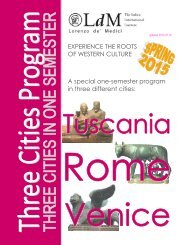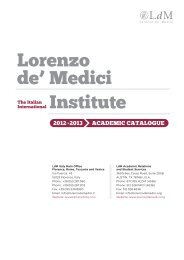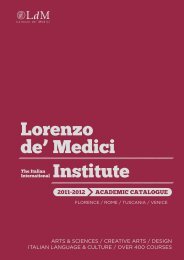aCademiC Catalog 2013-2014 - Lorenzo de Medici
aCademiC Catalog 2013-2014 - Lorenzo de Medici
aCademiC Catalog 2013-2014 - Lorenzo de Medici
You also want an ePaper? Increase the reach of your titles
YUMPU automatically turns print PDFs into web optimized ePapers that Google loves.
FLORENCE<br />
School of Arts & Sciences<br />
church in the Florentine area, supervised by a faculty tutor and<br />
the cooperating museum, or Florentine curia staff. The internship<br />
provi<strong>de</strong>s stu<strong>de</strong>nts with practical experience, especially in the<br />
field of cultural mediation and museum education, through<br />
direct observation of the various activities <strong>de</strong>veloped at the<br />
hosting museums and churches, individual studying and<br />
direct participation in gui<strong>de</strong>d tours at museums and churches.<br />
Through this experience stu<strong>de</strong>nts have the opportunity to learn<br />
and apply new professional skills, while directly interacting with<br />
institutional staff and the visitors.<br />
Note: Placement opportunities are limited and subject<br />
to change. Stu<strong>de</strong>nts who enroll must submit supporting<br />
documentation by the registration <strong>de</strong>adline, and acceptance is<br />
conditional upon result of an on-site interview during the first<br />
week of the term. Fluency in Italian may be advantageous.<br />
Prerequisites: Art History and Museum Studies majors of<br />
sophomore standing<br />
19th Century Art: from Neoclassicism to Post-<br />
Impressionism<br />
ART 365 F<br />
Cr: 3; Contact hrs: 45<br />
This course examines European art between c.1790 and c.1900.<br />
The start of this period corresponds to the passage from<br />
Neoclassicism to Romanticism, while the end corresponds to<br />
movements including Post-Impressionism that heral<strong>de</strong>d the<br />
avant-gar<strong>de</strong>s of the Twentieth Century. The Nineteenth Century<br />
was an era of enormous changes of many kinds (from politics<br />
to technology) in European society, and links between society,<br />
i<strong>de</strong>ology, culture and the visual arts are explored. Themes<br />
explored inclu<strong>de</strong>: critics and the public; exhibitions and salons;<br />
naturalism and realism; nationalism; Orientalism and Japonisme;<br />
nature and landscape; Impressionism; dreams and inspiration;<br />
heroism; literary and historical themes. Special focus is given to<br />
changing notions of mo<strong>de</strong>rnity. Artists studied inclu<strong>de</strong> David,<br />
Goya, Delacroix, Turner, Courbet, Monet, Degas, Van Gogh,<br />
Cezanne, Seurat, Gauguin, Ensor and Munch. Attention is also<br />
given to Italian artists and movements.<br />
Prerequisites: ART 180 Art History I, or ART 186 Art History II,<br />
or equivalents<br />
Avant-gar<strong>de</strong> and Mo<strong>de</strong>rnist Art (1900-1950)<br />
ART 370 F<br />
Cr: 3; Contact hrs: 45<br />
The aim of this course is to give stu<strong>de</strong>nts a thorough and<br />
comprehensive grounding in the conceptual and stylistic trends<br />
affecting artistic <strong>de</strong>velopment in the first half of the last century.<br />
The course inclu<strong>de</strong>s a survey of both European and American<br />
art of this period. The course is divi<strong>de</strong>d into two main sections:<br />
Section One (1900-1940): Post- Impressionism - The Mo<strong>de</strong>rn<br />
Movements; Section Two (1940-1960): Abstract Expressionism<br />
- Neo-Dada / Assemblage. The objective of this course is to<br />
introduce stu<strong>de</strong>nts to the philosophical and critical discourses<br />
of Mo<strong>de</strong>rnist painting. A mandatory one-day field trip may be<br />
inclu<strong>de</strong>d.<br />
Prerequisites: ART 186 Art History II, or equivalent<br />
Contemporary Art<br />
ART 375 F<br />
Cr: 3; Contact hrs: 45<br />
The aim of this course is to give stu<strong>de</strong>nts a thorough and<br />
comprehensive grounding in the conceptual and stylistic<br />
trends governing the art of the late 20th century. This period<br />
<strong>de</strong>als specifically with the transition from Greenbergian High<br />
Mo<strong>de</strong>rnism of the 60’s, through the <strong>de</strong>materialization of the<br />
art object in the 70’s, to the postmo<strong>de</strong>rn and <strong>de</strong>constructive<br />
theories of the 80’s and 90’s. The course is divi<strong>de</strong>d into two main<br />
sections: Section One (1960-1980): Pop Art - Photo-Realism<br />
(Europe and USA); Section Two (1980-1990’s): Postmo<strong>de</strong>rnism<br />
- Current Trends (Europe and USA). The objective of this<br />
course is to introduce stu<strong>de</strong>nts to the philosophical and critical<br />
discourses relating to Mo<strong>de</strong>rnism and Postmo<strong>de</strong>rnism. A<br />
mandatory one-day field trip may be inclu<strong>de</strong>d.<br />
Prerequisites: ART 186 Art History II, or equivalent<br />
Art Expertise<br />
ART 405 F<br />
Cr: 3; Contact hrs: 45<br />
The function of art expertise is to make a precise assessment<br />
of a work of art in terms of its aesthetic significance, its<br />
material evi<strong>de</strong>nce, its documentary importance (history) and<br />
its market value. With the birth of the art market, in addition<br />
to the art collector and the art <strong>de</strong>aler we now find the art<br />
consultant: an expert in the field of visual arts who is able to<br />
recognize the characteristics of specific periods, schools and<br />
artists. Furthermore, he or she is able to distinguish an original<br />
work from a copy or an imitation and assess its market value.<br />
Beginning with the <strong>de</strong>finition of what a work of art is and a<br />
discussion of the criteria to <strong>de</strong>fine quality, the course leads<br />
stu<strong>de</strong>nts through the ins and outs of both selling and buying.<br />
The following issues are addressed: the roles of the connoisseur<br />
and the art consultant; classification and cataloguing of<br />
works of art (dossiers and publications); scientific diagnostic<br />
procedures; fakes and artistic revivals; Italian and international<br />
art legislation; auctions (with visits to the Pandolfini auction<br />
house in Florence).<br />
Prerequisites: Art History majors<br />
Museum Education<br />
ART 450 F<br />
Cr: 3; Contact hrs: 30<br />
Using case studies and theoretical analyses, this course<br />
explores how museums reach out to their communities,<br />
including the staging of events for public outreach, teaching<br />
from objects and teaching others (gui<strong>de</strong>s, volunteers, interns)<br />
to teach from objects, and the educational use of technologies.<br />
It will also examine the role of the museum educator and his or<br />
her engagement with the phenomena of formal, informal, and<br />
lifelong learning. Stu<strong>de</strong>nts interested in pursuing a career as a<br />
museum educator are strongly encouraged to enroll.<br />
Note: un<strong>de</strong>rgraduate cross-listing of ART 604. Applicants<br />
must submit CV and short essay for instructor review during<br />
the registration process; further materials and interview may<br />
be nee<strong>de</strong>d.<br />
Prerequisites: Second-semester juniors with major in a related<br />
field; instructor’s permission required<br />
Museum: Ethics and the Law<br />
ART 460 F<br />
Cr: 3; Contact hrs: 30<br />
This course introduces the stu<strong>de</strong>nt to the legal and ethical<br />
issues faced by museums as repositories of cultural property<br />
across the world. Issues explored on a comparative international<br />
basis inclu<strong>de</strong> copyright, censorship, public interest, appropriate<br />
conservation, theft, dubious provenance, and repatriation of art<br />
and artifacts.<br />
Note: un<strong>de</strong>rgraduate cross-listing of ART 606. Applicants<br />
must submit CV and short essay for instructor review during<br />
the registration process; further materials and interview may<br />
be nee<strong>de</strong>d.<br />
Prerequisites: Second-semester juniors with major in a related<br />
field; instructor’s permission required<br />
Art History – M.A. in Museum<br />
Studies program<br />
Museums and the Public I: People and I<strong>de</strong>as<br />
ART 501 F<br />
Cr: 3; Contact hrs: 37,5<br />
This course addresses the various roles museums play in society,<br />
accentuating the position of the museum as a significant cultural<br />
institution whose form and very existence <strong>de</strong>pends upon a rich<br />
interchange with its community, local and global. It is <strong>de</strong>signed<br />
largely as a series of invited lectures by museum professionals<br />
such as museum directors, curators, donors, fundraisers, docent<br />
trainers, web <strong>de</strong>signers etc., with both theoretical and practical<br />
knowledge of museums. These lectures, combined with weekly<br />
readings, will serve as springboards for individual analysis and<br />
class discussion.<br />
56<br />
LdM Aca<strong>de</strong>mic <strong>Catalog</strong> <strong>2013</strong>-<strong>2014</strong>





